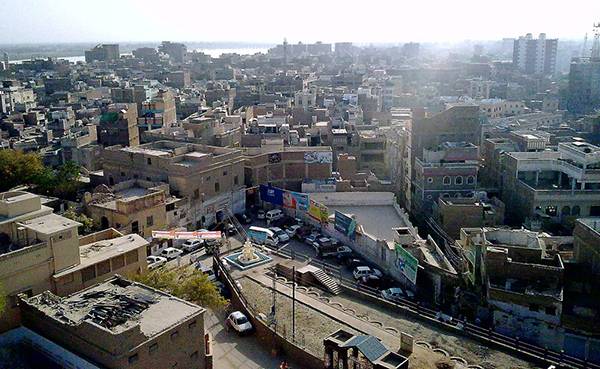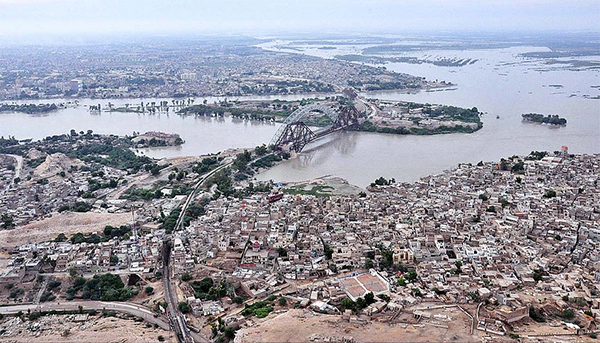
Sindh’s third biggest city, Sukkur, where there were no high-rise buildings till the early 1990s, has turned into a jungle of cement and concrete by builders. Though the Sindh Building Control Authority claims that it has not granted permission to anyone to construct beyond ground-plus-four floor buildings, high-rise buildings have mushroomed in prime localities including Queen’s Road and Barrage Road. As a result, all the main roads and market areas have become choked because none of this was properly planned.
The reason for the rise of the high-rise is simple: they signify safety. And safety is what the Hindu population of the area need. Sukkur used to have 310 Hindu families till roughly 2007 but in the last ten years, the number has gone up to 2,600 families. The influx started in 2010 and continued till about 2013, specifically because kidnappings for ransom and other crimes reached epidemically high numbers. Added to the fear of kidnappings was the fear of forced conversions. Every month, an estimated 20 or more Hindu girls are abducted and converted, says the Human Rights Commission of Pakistan. (These figures are rough). Hindus form just 2% of Pakistan’s population with the majority of them living in Sindh.
The Hindus were being targeted in the countryside outside Sukkur. They represented soft targets because Hindus are not part of (Muslim) tribes (Mahars, Jatois etc) and thus do not have powerful backing. They were also wealthy business people. Sukkur was considered comparatively safer for the Hindu families from Ghotki, Khairpur, Shikarpur, Jacobabad, Kashmore-Kandhkot and other areas.
The president of the Hindu Panchayat in Upper Sindh, Mukhi Eshwar Lal Makheja, confirmed this trend. Besides moving to Sukkur, he said, many Hindu families also shifted their business here. “But there are still many Hindus who have their business in other cities and towns,” he added. Of course, the prime reason for this migration was the bad law and order situation in many parts of upper Sindh, he said. But after settling in Sukkur, the families realised that living in the city not only came with safety, it meant better schools and health compared to those of other smaller cities and towns.
Till 2014 around 100 high-rise buildings were constructed in the city, out of which more than 80 buildings are said to have been built without the proper approval of the authority concerned. This means that the builders have scrimped on important yet basic facilities such as parking, ventilation, drainage and water supply systems. Despite these shortcomings, the flats in these buildings are in high demand and more are under construction. The benefit of living in a high-rise flat is that guards can be posted at the bottom. Ironically, many of the builders are Hindus, who have garnered strong political backing from an influential politician in the city.

Most of the high-rise buildings constructed in Sukkur from 1992 to 2010 were approved by the Sukkur Municipal Corporation and therefore the newly created Sindh Building Control Authority blames the SMC for all the illegal or shoddy construction. For its part, however, the SMC blames the SBCA for what happened after 2010. Amid the blame game between the two, though more of these buildings are coming up.
One of the former directors of the SBCA claims that he himself had never approved any building beyond ground-plus-four. But when asked how ten-storey high buildings are coming up, he candidly said that you can get extra stories approved with political influence, but not before paying Rs500,000 for the approval of each extra storey.
To give you an idea of how unplanned this development is consider that the Sukkur Municipal Corporation does not possess any map of the city, except for one prepared back in 1930. The Sindh Building Control Authority only possesses the plans of some under-construction high-rise buildings. The rampant building has, as a result, eaten into the city’s amenity plots, municipal, railways and revenue lands. A ground-plus-seven and eight narrow buildings have been constructed in the thickly populated market areas on a mere 120 square yards and even less.
Hot real estate has emerged on Bunder Road, Miani Road, Bhutta Road, Queen’s Road and Minara Road which has been taken up by Hindu families, who pay extremely high rents. And if you want to buy, it isn’t cheap either. One residential unit in an under-construction Dolphin Towers at Minara Road has been booked for more than Rs11 million and its resale price has gone up to Rs14 million, according to one real estate agent. People are willing to pay and prices have skyrocketed not just because of demand, but because of location. “Residents of Sukkur are reluctant to move to the societies off Airport road,” explained Mukhi Eshwar Lal. “As far as the Hindus are concerned, they like to live in the city along with their community and thus feel more safe than living on the outskirts of the city.”
The reason for the rise of the high-rise is simple: they signify safety. And safety is what the Hindu population of the area need. Sukkur used to have 310 Hindu families till roughly 2007 but in the last ten years, the number has gone up to 2,600 families. The influx started in 2010 and continued till about 2013, specifically because kidnappings for ransom and other crimes reached epidemically high numbers. Added to the fear of kidnappings was the fear of forced conversions. Every month, an estimated 20 or more Hindu girls are abducted and converted, says the Human Rights Commission of Pakistan. (These figures are rough). Hindus form just 2% of Pakistan’s population with the majority of them living in Sindh.
Sukkur used to have 310 Hindu families till roughly 2007 but in the last ten years, the number has gone up to 2,600 families. The influx started in 2010 and continued till about 2013
The Hindus were being targeted in the countryside outside Sukkur. They represented soft targets because Hindus are not part of (Muslim) tribes (Mahars, Jatois etc) and thus do not have powerful backing. They were also wealthy business people. Sukkur was considered comparatively safer for the Hindu families from Ghotki, Khairpur, Shikarpur, Jacobabad, Kashmore-Kandhkot and other areas.
The president of the Hindu Panchayat in Upper Sindh, Mukhi Eshwar Lal Makheja, confirmed this trend. Besides moving to Sukkur, he said, many Hindu families also shifted their business here. “But there are still many Hindus who have their business in other cities and towns,” he added. Of course, the prime reason for this migration was the bad law and order situation in many parts of upper Sindh, he said. But after settling in Sukkur, the families realised that living in the city not only came with safety, it meant better schools and health compared to those of other smaller cities and towns.
Till 2014 around 100 high-rise buildings were constructed in the city, out of which more than 80 buildings are said to have been built without the proper approval of the authority concerned. This means that the builders have scrimped on important yet basic facilities such as parking, ventilation, drainage and water supply systems. Despite these shortcomings, the flats in these buildings are in high demand and more are under construction. The benefit of living in a high-rise flat is that guards can be posted at the bottom. Ironically, many of the builders are Hindus, who have garnered strong political backing from an influential politician in the city.

Most of the high-rise buildings constructed in Sukkur from 1992 to 2010 were approved by the Sukkur Municipal Corporation and therefore the newly created Sindh Building Control Authority blames the SMC for all the illegal or shoddy construction. For its part, however, the SMC blames the SBCA for what happened after 2010. Amid the blame game between the two, though more of these buildings are coming up.
One of the former directors of the SBCA claims that he himself had never approved any building beyond ground-plus-four. But when asked how ten-storey high buildings are coming up, he candidly said that you can get extra stories approved with political influence, but not before paying Rs500,000 for the approval of each extra storey.
To give you an idea of how unplanned this development is consider that the Sukkur Municipal Corporation does not possess any map of the city, except for one prepared back in 1930. The Sindh Building Control Authority only possesses the plans of some under-construction high-rise buildings. The rampant building has, as a result, eaten into the city’s amenity plots, municipal, railways and revenue lands. A ground-plus-seven and eight narrow buildings have been constructed in the thickly populated market areas on a mere 120 square yards and even less.
Hot real estate has emerged on Bunder Road, Miani Road, Bhutta Road, Queen’s Road and Minara Road which has been taken up by Hindu families, who pay extremely high rents. And if you want to buy, it isn’t cheap either. One residential unit in an under-construction Dolphin Towers at Minara Road has been booked for more than Rs11 million and its resale price has gone up to Rs14 million, according to one real estate agent. People are willing to pay and prices have skyrocketed not just because of demand, but because of location. “Residents of Sukkur are reluctant to move to the societies off Airport road,” explained Mukhi Eshwar Lal. “As far as the Hindus are concerned, they like to live in the city along with their community and thus feel more safe than living on the outskirts of the city.”

